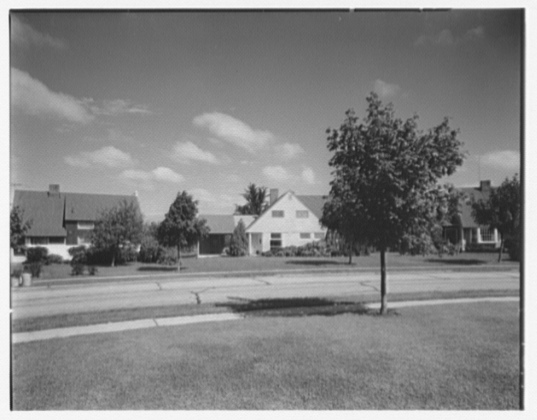25 Winding Lane, Levittown, New York, in August 1958. An architectural photography company took this photo for House Beautiful magazine. LIBRARY OF CONGRESS, Gottscho-Schleisner Collection
written for Blue Ridge Press

In the 1960s my three brothers, sister, parents, and I used to visit my Uncle Woody, who lived in Levittown, Pennsylvania, one of the most famous suburban developments in America.
Uncle Woody was visibly proud of his little house. It was immaculate inside and out. He put a bowl of fancy chocolates on the coffee table, and we sat around his cramped living room enjoying the picture window. At Christmastime, he decorated the whole place, even wrapped tinsel around the railing of a staircase that seemed to lead nowhere; it, in fact, ended at an attic trap door.
Uncle Woody died in his fifties of a heart attack that came on suddenly while painting his house. It was 1978. I was a sophomore in college, and my personal experience of Levittown ended just as I was developing a young history major’s contempt for suburban developments like those found in the three Levittowns—Woody’s in Pennsylvania, another in New York, and one in New Jersey, since renamed Willingboro.
It has become politically correct since for social critics to speak of Levittown as a code word for everything gone wrong in American suburbia: here were thousands of cookie-cutter houses, plopped down many miles from shopping and jobs. Here were families all living the same conformist life, with prim front lawns on which no one seemed to do anything. Here were endlessly curving streets with names that all sounded alike.
And here were veterans’ families bedazzled by the austere park-like setting: in one old documentary a young Levittown wife stands in the developer’s office insisting on a particular home lot only because it is on Butterfly Lane. The land clerk winks at the husband and says, “Better let her have her way!”
Yes, it’s easy to critique Levittown and developer William J. Levitt, and scholars have done so, seeing it as the antithesis of community and sustainability. But there was plenty good about Levittown. People talked with their neighbors. The children played safely on the streets and yards, and their parents could watch them and the neighbors’ kids from inside the picture windows. People worked on their houses, felt incredible pride of ownership, and could afford the payments.
By far the most admirable feature of Levittown was that the homes were small. They were, in fact, typically smaller than the homes in which the World War II veterans who inhabited them had grown up. But they were big enough—and surveys consistently showed that the residents thought so.
The people who lined up to buy $8,000 Levittown Cape Cods, ranches and other basic box designs were delighted to live in homes that were less than 1,000 square feet, the average U.S. house size of the time.
Today that average size has mushroomed to just under 2,500 square feet—with 6,000 square foot starter castles common—the result of buyers wanting bigger and better homes than their parents had, and of developers wanting to build them.
Recent economic and environmental events tell us it is clearly time we reconsidered our path to growth. Though it be heresy, I suggest that we Americans return to Levittown—to a comfortable scaled-back lifestyle.
We should do so for two reasons. First, I’m convinced that people are naturally drawn to small dwellings, even as they tell themselves otherwise. Second, Americans have been using ever more energy, per capita, since the 1960s as our lifestyles and lavish homes demand it—energy that is growing expensive and scarce.
Certainly there is no evidence that our big homes, fed on mega-doses of fossil fuel, have made us any happier than my Uncle Woody. I find it strange how many Americans escape their houses each summer, and pay huge sums to vacation at little cabins in the woods and cottages at the shore. I’m regularly reminded of “Frontier House,” a reality show in which three families, including a wealthy California couple and their children, give up their Malibu mansion for three months to inhabit a one-room cabin. When the family returns to affluence, the mom misses seeing her kids, now hidden away in their individual rooms or in the pool. She says she never felt cramped in the cabin.
ExxonMobil, in a recent annual report, predicts that the world will grow progressively hungry for energy as our rising population “continues to advance and seek better living standards.” Not surprisingly, the energy giant urges increased fossil fuel production to meet our growing lifestyle demands.
The question is: What is it we are demanding? At what point does growth become obsessive and obscene, driven by profit rather than the pursuit of happiness? When, if ever, will we scale back our expectations, to feel the same excitement that young wife felt at inhabiting a house smaller than 1,000 square feet on Butterfly Lane?
© 2009 www.blueridgepress.com
About This Article
Editor Glenn Scherer did with me what I try to do with those who write for Appalachia journal: he talked to me a lot about what I was aiming for before I started writing this essay. It took me many years to understand that, while I don’t like many aspects of suburban and exurban developments, those like Levittown made me feel safe as a child. I wish Uncle Woody were still around to read this. I think he would have laughed with delight. This article appears here with the permission of Blue Ridge Press, which posted it on August 6, 2009. Among the newspapers that picked this up were New York Newsday.
